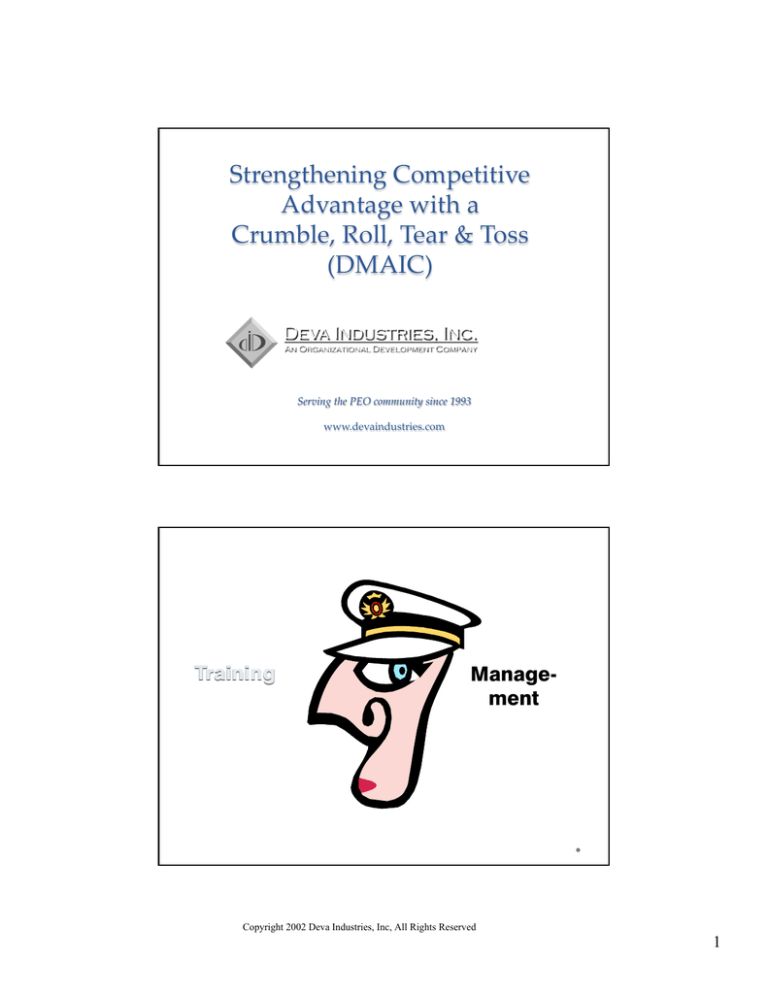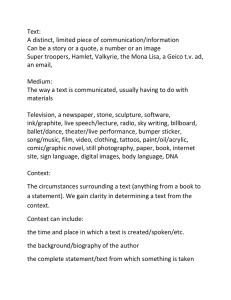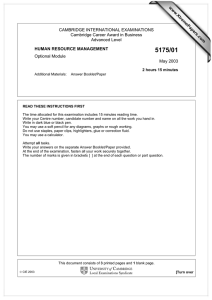
Strengthening Competitive
Advantage with a
Crumble, Roll, Tear & Toss
(DMAIC)
Deva Industries, Inc.
An Organizational Development Company
Serving the PEO community since 1993
www.devaindustries.com
Training
Management
Copyright 2002 Deva Industries, Inc, All Rights Reserved
1
What are some
of your
challenges
3
Process Simulation:
Crumble, Roll, Tear, Toss
4
Copyright 2002 Deva Industries, Inc, All Rights Reserved
2
Input
5
Crumble
6
Copyright 2002 Deva Industries, Inc, All Rights Reserved
3
Roll
7
Tear
8
Copyright 2002 Deva Industries, Inc, All Rights Reserved
4
Toss
9
Output
10
Copyright 2002 Deva Industries, Inc, All Rights Reserved
5
Crumble, Roll,
Tear, Toss
11
How would you
approach an
improvement
opportunity
12
Copyright 2002 Deva Industries, Inc, All Rights Reserved
6
Clearly define opportunity in
quantitative terms
• Reduce ball production time to 1
minute
13
How do you improve?
Copyright 2002 Deva Industries, Inc, All Rights Reserved
7
SIPOC
Supplier
Inputs
Paper
Paper
provider
Tearer
Tosser
Outputs
Paper
ball
paper
Crumbler
Roller
Process
Receive
Customer
Final
Recipient
Crumble
Crumbler
paper
into
ball
Unroll &
tear
corners
Toss ball
into air
Present
ball
Roller
Roll
Tearer
Tosser
15
16
Copyright 2002 Deva Industries, Inc, All Rights Reserved
8
17
What does the customer value?
18
Copyright 2002 Deva Industries, Inc, All Rights Reserved
9
Bang
Value
Buck
19
Sale
Service Billing
Satisfied?
Customer
Entry
Value Stream
Delivery
Support
20
Copyright 2002 Deva Industries, Inc, All Rights Reserved
10
Value drives Satisfaction
Source: American Customer Satisfaction Index (ACSI)http://www.theacsi.org/about-acsi/thescience-of-customer-satisfaction
21
To improve, must look at the
process
Bang
Value
Buck
22
Copyright 2002 Deva Industries, Inc, All Rights Reserved
11
“If you can’t measure it, you can’t
improve it.” – Peter Drucker
23
Measures Create Behaviors
24
Copyright 2002 Deva Industries, Inc, All Rights Reserved
12
What should
we measure
25
Run Chart – Performance Over Time
Your Intended
Career Path
Why You
Drink
Your Actual
Career Path
Birth
Death
26
Copyright 2002 Deva Industries, Inc, All Rights Reserved
13
Ball Processing Time (Seconds)
Time to process a ball
140
120
100
80
60
40
20
0
1
2
3
4
5
Days
27
Time to process a ball, by activity
Ball Processing Time (Seconds)
Crumble
Roll
Tear
Toss
Retrieve Drop
140
120
100
80
60
40
20
0
1
2
3
Days
4
5
28
Copyright 2002 Deva Industries, Inc, All Rights Reserved
14
How does our
current performance
stack up to customer
expectation
29
Histogram – Frequency Distribution
Use of fingers in traffic
Thumb
Index
Middle
Ring
Pinky
30
Copyright 2002 Deva Industries, Inc, All Rights Reserved
15
How often each value occurs
Current Performance
12
10
Quantity
8
6
4
2
0
50 55 60 65 70 75 80 85 90 95 100 105 110 115 120 125 130 135
Ball Processing Time (Seconds)
31
How often each value occurs
versus what the customer wants
Current Performance
Customer Wants
12
10
Quantity
8
6
4
2
0
50 55 60 65 70 75 80 85 90 95 100 105 110 115 120 125 130 135
Ball Processing Time (Seconds)
32
Copyright 2002 Deva Industries, Inc, All Rights Reserved
16
Why are we
slow?
33
Why are we slow – Root Cause?
Measures
Materials
Process
•
•
•
•
•
Unclear what to do
Too many steps
Over-processing
Linear flow
Bottleneck
Slow
• Dropped ball
• People located
• People don’t have far away
ability or skills
• Things in the way
• Interruptions
• Slow workers
Equipment
People
Environment
34
Copyright 2002 Deva Industries, Inc, All Rights Reserved
17
5 Whys
• Bottleneck – Why?
o Person tearing the paper is slow – Why?
• Doesn’t have proper skills – Why?
o Not trained – Why?
• No time or resources to train
o Too many, too fast
o Linear flow
o Etc.
35
7+ Areas of Waste (Muda)
1. Inventory (Bottleneck)
2. Motion (things in the way)
3. Transportation (Tossing ball far away)
4. Over processing (Un-roll/re-roll paper)
5. Defects & Errors (Retrieving dropped ball)
6. Waiting (waiting for bottleneck to clear)
7. Overproduction!
Also
8. Unused human capacity
9. Unsafe conditions
36
Copyright 2002 Deva Industries, Inc, All Rights Reserved
18
Many reasons why the
process is slow. How
do you determine
which to address?
37
Pareto Chart
People who find you on Facebook
45
40
Number of People
35
30
25
20
15
10
5
0
High school
people you
hated
College
people you
hated
Work
colleagues
you hate
Actual friends
38
Copyright 2002 Deva Industries, Inc, All Rights Reserved
19
Collect Data on Check Sheet
Events
Day
Total
Things that slow us down
1
2
3
4
5
Interruptions
2
1
0
0
1
4
Questions
4
2
1
0
0
7
Bottleneck
5
5
5
5
5
25
Interference
3
2
1
0
0
6
Drops
5
2
4
3
2
16
12
11
8
8
58
Total 19
39
Frequency
30
25
Count
20
15
10
5
0
Bottlenecks
Drops
Questions
Interference Interruptions
40
Copyright 2002 Deva Industries, Inc, All Rights Reserved
20
Time and Variation
Crumble
Roll
Tear
Toss
Retrieve Drop
140
120
Seconds
100
80
60
40
20
0
1
2
3
4
Balls Processed
5
41
How To Stop Dropping Ball?
• People located far away
o Stand closer together
• Interference/Things in the way
o Remove interference / rearrange
• Not clear what to do
o Define the process and responsibilities
o Develop clear rules and procedures
o Train, practice & communicate
• People don’t have ability or skills
o Provide tools to help
o Use skilled people in those positions instead
o Poka-Yoke
• Too many too fast
o Set realistic goals
o Provide sufficient resources
o Filter pre-qualify input
42
Copyright 2002 Deva Industries, Inc, All Rights Reserved
21
How To Get Rid of Bottleneck?
• Person is slow
o Provide time/resources for training (remember root cause:
no skills, not trained, no time/resources)
• Inventory build up
Perform tear before crumbling and passing along
Add additional resources to help with that step
Pre-quality inputs so not wasting time on unqualified
Flexible work teams, ability to move resources when/where
needed, cross training
o Use Kanban
o
o
o
o
• Interference/Torn corners in the way
o Provide trash bins
43
How do we
choose which to
implement
44
Copyright 2002 Deva Industries, Inc, All Rights Reserved
22
Prioritization Matrix –Drops
Options
Criteria &Weight Effective
.6
Time
.2
Cost
.2
Total
Stand closer together
Remove interference
Define process
Develop clear rules
Train & practice
Use skilled people
Provide tools
Error Proof (Poka-Yoke)
Set realistic goals
45
Prioritization Matrix –Drops
Options
Criteria &Weight Effective
.6
Time
.2
Cost
.2
Total
Stand closer together
9
Remove interference
6.6
Define process
6.6
Develop clear rules
6.6
Train & practice
5.8
3
Use skilled people
2.6
Provide tools
9
Error Proof (Poka-Yoke)
2.6
Set realistic goals
= 9 Excellent
= 3 Fair
= 1 Poor
46
Copyright 2002 Deva Industries, Inc, All Rights Reserved
23
Prioritization Matrix- Bottleneck
Options
Criteria & Weight Effective
.6
Time
.2
Cost
.2
Total
Rearrange task order
9
Pull system (Kanban)
3
Add resources
5.8
Pre-qualify inputs
6.6
Flexible work teams
2.6
Provide Trash bins
5.4
More Training Time
2.2
= 9 Excellent
= 3 Fair
= 1 Poor
47
What if solution
conflicts with
strategy?
48
Copyright 2002 Deva Industries, Inc, All Rights Reserved
24
Repeat simulation
with improvements
•
•
•
•
Remove interference
Stand closer together (Poka Yoke)
Rearrange task order (reduces steps)
Clearly define process
49
Tear, Roll, Toss
50
Copyright 2002 Deva Industries, Inc, All Rights Reserved
25
Tear, crumble
& pass
What does new
process look like?
51
Streamlined Process
52
Copyright 2002 Deva Industries, Inc, All Rights Reserved
26
Control Chart
Previous Time
New Time
140
120
Seconds
100
80
60
40
UCL
Average
20
LCL
0
1
2
3
4
5
Balls Processed
53
Control Chart
140
Previous Time
New Time
120
Seconds
100
But
customer
wanted it
here
80
60
40
20
0
1
2
3
4
5
Balls Processed
54
Copyright 2002 Deva Industries, Inc, All Rights Reserved
27
What
does the
customer
value?
55
DMAIC
• Define
o SIPOC, Process Map, Value Stream, VOC
• Measure
o Run Chart, Histogram, Check Sheet
• Analyze
o Root Cause Analysis, 5 Whys, Pareto
• Improve
o Brainstorming, Prioritization Matrix, Kanban, Poka-Yoke
• Control
o Control Chart
Tools noted here are neither all encompassing nor sequential. They &/or
many other more sophisticated statistical tools can be used at any time
to gain insight into a particular problem
56
Copyright 2002 Deva Industries, Inc, All Rights Reserved
28
Improvement Opportunities
• Use business strategy and objectives, and
Voice of Customer as guide
• Focus on:
o
o
o
o
Safety, Quality, Cost, Delivery/Time
Critical few (Pareto principle)
High leverage areas - what creates greatest value
That which has greatest risk if there is a failure
• Good targets for elimination:
o
o
o
o
o
The 7+ areas of waste (Muda) Non-value adding activities
Variation
Putting out fires
Pet peeves you’ve learned to live with
57
Look at the process from a total
systems perspective
Training
Management
Copyright 2002 Deva Industries, Inc, All Rights Reserved
29
Understand what the customer values
59
“Nothing is
less productive
than to make
more efficient
what should
not be done at
all.”
- Peter Drucker
60
Copyright 2002 Deva Industries, Inc, All Rights Reserved
30
Documenting processes
is not about the
document at the end, it’s
about the conversation
leading up to it, and the
framework it provides
for improvement.
61
Take a bad process
and make it better
62
Copyright 2002 Deva Industries, Inc, All Rights Reserved
31
Resources
• Six Sigma Marketing: From Cutting Costs to Growing Market
Share, R. Eric Reidenbach
• Applying the Science of Six Sigma to the art of Sales &
Marketing, Michael J. Pestorius
• Transactional Six Sigma for Green Belts, Samuel E. Windsor
• Sales and Marketing the Six Sigma Way, Michael Webb and
Tom Gorman
• Lean Solutions: How Companies and Customers Can Create
Value and Wealth Together, James P. Womack, Daniel T.
Jones
• The Loyalty Effect: The Hidden Force Behind Growth, Profits
and Lasting Value, Frederick F. Reichheld
• ASQ Quality Tools A to Z: http://asq.org/learn-aboutquality/quality-tools.html
• PEO/HRO Process Framework, Virginia G. Frazier
63
Copyright 2002 Deva Industries, Inc, All Rights Reserved
32




